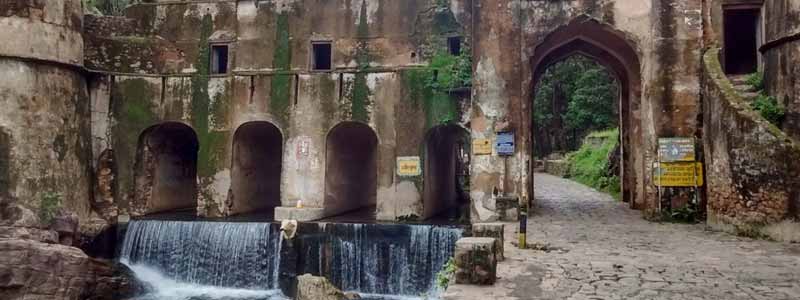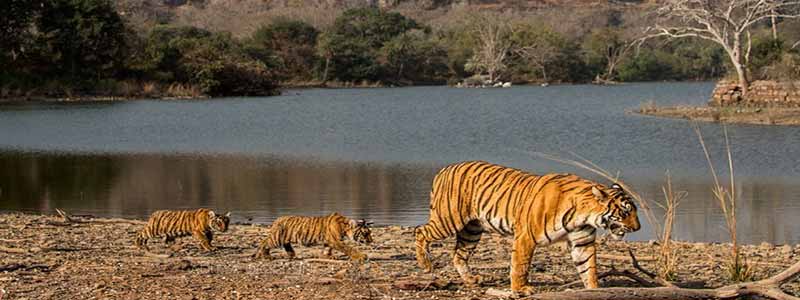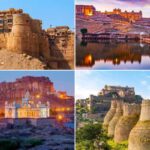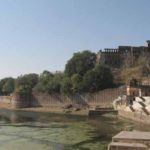Ranthambore Fort, Rajasthan is one of India’s most historically significant states, and various forts, such as the Ranthambore Fort, stand witness to their mighty reign. In truth, Ranthambore Fort is one of Rajasthan’s oldest, most gorgeous, and most representative forts. The royal Chauhan family built it in the 12th century, this fort is also a World Heritage Site, as declared by UNESCO. If you want to experience the true essence and history of Rajasthan, you must visit Ranthambore and the Fort that is the city’s crowning glory.
The Ranthambore Fort stands on the skyline of the Ranthambore National Park, looking over the settlements and surrounding landscape underneath and offering some of the most breathtaking views from its ramparts. You can also see the dense foliage and grasslands of the Ranthambore National Park from the fort, which is another reason tourists flock to the fort from all parts of the country.
The Ranthambore Fort is also a marvelous specimen of Rajput architecture. The fort is surrounded with large stone walls, stone steps, pillars and large domes which make the fort appear majestic. Due to the proximity of the National Park and wildlife reserve, you might also find birds, monkeys and even peacocks in the fort complex. Ranthambore Fort is the perfect place to go sightseeing, trekking, hiking or nature-walking when you are in Rajasthan.

History of Ranthambore Fort
The Ranthambore Fort is one of the oldest and most historically significant forts in Rajasthan. Due to its location, it acted as a prime trade link between North and Central India and was captured and fortified by many rulers through centuries since its construction.
The actual date of construction of the fort is unconfirmed. However, many believe that construction was started in the 8th century by King Jayant, the Chauhan ruler. The fort was completed sometime in the early 1100s.
Since then, the fort has been attacked and fortified by many rulers, including Prithviraj Chauhan I, Muhammad Ghori, Prithviraj Chauhan III, Iltutmish, Sultan Balban and also the emperor of the Delhi Sultanate- Alauddin Khilji. The fort was finally conquered by the Mughal ruler- Akbar in 1558 and it remained under the control of the Mughals till the middle of the 18th century.
In 1763, after the influence of the Mughal empire started to diminish, the Rajput ruler Sawai Madho Singh attempted to capture the fort unsuccessfully, and instead fortified a village called Sherpur near the fort and renamed it Sawai Madhopur.
He was then the ruler of the Jaipur state and after creating Sawai Madhopur, he was eventually granted control of the Ranthambore Fort by the Mughal ruler. Sawai Man Singh built a railway line between the cities of Jaipur and Sawai Madhopur during the reign of the British over India. This railway station has since expanded to become the primary access point to Ranthambore Fort.

Ranthambore Fort – Attractions and Places to Visit
Apart from the Ranthambore ka Kila itself, there are quite some places that are quite popular and must not be missed when in Ranthambore.
- Trinetra Ganesha Temple
The Trinetra Ganesh Temple is one of the oldest temples in India, built with red Karauli stone. It is situated inside the premises of the Ranthambore Fort, which is one of the most famous tourist attractions in all of Rajasthan. This temple is a one-of-a-kind temple, where Lord Ganesha is represented with all the members of his family.
The Sringar Aarti is performed at 9:00 am. The Bhog for the Lord is performed at 12:00 noon. The Sandhya or the evening Aarti, during the sunset is performed at 6:00 pm in summer and at 5:45 pm in winter. The Shayan Aarti is performed at 8:00 pm in the late evening, followed by a prayer in chorus chanted by the priests of the temple and the main devotees of the Lord. Even if you are not religious, or you want to see the fort and temple for their historical or architectural significance, the aartis are a spectacle to behold
In Hindu mythology, Lord Ganesha is considered to be the powerful God of wealth, fortune, wisdom and education. Therefore, all year round, this temple receives thousands of marriage invitations and wish-fulfilment letters addressed to Lord Ganesh, addressed with the faith that the Lord will fulfil the wishes of His devotees.
Devotees from all over the world visit this temple throughout the year and even construct little images of houses near the temple premises, which in itself is an attractive feature about the place. People do this in the hope that their Lord will fulfil their dreams of buying a house or making one. Here, Ganesha is worshipped five times daily in the form of different “aartis”. The aarti or the first worshipping ceremony starts in the morning with the ‘morning aarti’ or the Prabhat Aarti.
- Ranthambore Park
Ranthambore National Park is located about 13.5 kilometers from the city of Sawai Madhopur in Rajasthan. Located at the junction of the Aravali and Vindhya hill ranges, this is one of the finest places to view wild animals, especially as they are used to being stared at here. The park covers an area of approximately 400 sq km, and if combined with the area of Sawai Man Singh Sanctuary area, is around 500 sq km.
Ranthambore National Park is dotted with structures that remind you of bygone eras. There are numerous water bodies scattered all across the park, which provide perfect relief to the wild animals during the scorching hot days in summers. A huge fort, after which the park is named, towers over the park atop a hill. There are many ruins of bygone eras scattered all over the jungle, which give it a unique, wonderful and mixed flavour of nature, history and wildlife. Tigers at Ranthambore National park have been known to even hunt in full view of human visitors.
- Malik Talao
Malik Lake is the smallest of the lakes in Ranthambore, but is immensely popular for the frequent views of wildlife that are offered here. Despite of its small size the banks are often teeming with several wild animals and birds. The Indian Marsh Crocodiles or Mugger can also be found here so one must approach the banks with extreme caution. Nevertheless, due to its high wildlife activity, the lake is one of the best places to capture the animals with your camera. It is also one of the few places where spotting tigers is extremely frequent.
- Padam Talao
Located deep inside the Ranthambore National Park, Padam Talao is one of the largest lakes in the city. It is believed that this is the very lake where Princess Padmavati would bathe, and also the place where she committed sati. The beautifully ornate Jogi Mahal stands in close proximity to the lake.
Surrounded by dense forests, the lake is frequented by several animals who make their way to the lake to drink water in the sweltering heat. One can also spot the rare Chinkara Deer in the morning.
Since several animals hunt in close proximity to the lake, it is a great spot for wildlife photography. In the summer, when the water starts drying out, you can spot crocodiles and other animals during the summers. Although you cannot go near it, you can catch a glimpse of it while enjoying a jeep safari, or from the Ranthambore Fort.

Best Time to Visit Ranthambore Fort
The best time to visit Ranthambore Fort, and Rajasthan in general, is between the months of October and February. This is the winter season in the area and is the most pleasant time to go sightseeing, trekking, hiking and touring in Rajasthan. The state, being a desert area, can get scorching during the summer, making your travels uncomfortable and exhausting.
How to Reach Ranthambore Fort
Ranthambore Fort is a very popular tourist attraction in Rajasthan. It is located 17km away from the main town of Sawai Madhopur, which also means it is very accessible. You can travel to the fort by road, railway and air:
By Road: There is a well-connected bus service to and from Ranthambore which can take you directly to Ranthambore Fort. State-run buses connect all the major cities and towns in and around Rajasthan.
By Train: The nearest railway station is located at Sawai Madhopur, which is 10km away from the Ranthambore Fort. Several trains from all the major cities nearby stop at frequent intervals at the station.
By Air: The nearest airport is the Sanganer Airport in Jaipur, where flights come in from all parts of the country and from the world. Jaipur is located 157km away from Ranthambore Fort, which can be accessed by buses and hired cars.








